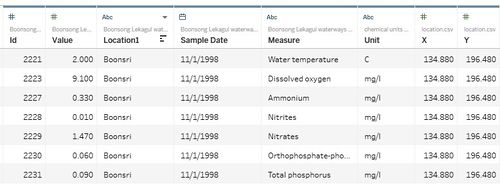ISSS608 2017-18 T3 Assign Lim Wee Kiong Dashboard Design
|
|
|
|
|
|
|
Dashboard Methodology
Joining the Data Sources
The first step is to join the 3 data sources into one and do some Exploratory Data Analysis:
Location and the Waterway data points will be joined as an inner join while the Waterway data points are joined with the units of measurements as a right outer join.
The sample joined data is shown here:
It contained:
- ID: ID of the Sample Reading
- Value: Value of the Sample Reading
- Location1: Location of the Reading
- Sample Date: Date of the Reading
- Measure: The measure of the Sample Reading
- Unit: Unit of the Sample Reading
- X / Y: X and Y coordinates of the Location
The challenge for this challenge is to find patterns or insights from 100+ measures which are of different natures and exhibit different behaviour. I designed a couple of interactive dashboards to sieve through the data. Here are brief introductions of how they are designed and what are their potential usage. The insights gathered are done through variations of the following 4 interactive dashboards:
Dashboard 1: Calendar View of Sample Counts
This is used to have an over-arching view of the number of sample readings taken for each measure and each location. We can then understand whether the data were obtained regularly or if there are some gaps in data-gathering.
Step 1. For Sample Dates, break down to Month in [Columns] and Year in [Rows]. This enables me to have a clear view of the data across the years (1998 to 2016) and over the months (Jan to Dec)
Step 2. Drag Id to [Details]. Change the [Measure] to [Count]. This is because I am interested in the number of readings taken for a period for individual locations.
Step 3. Measure and Location1 are added to the [Filters] as [Multiple Values(List)]. I can then filter the data based on location and measure
Step 4. Location1 and Measure are added to the [Tooltip] to provide more information.
Back to Dropbox Page



